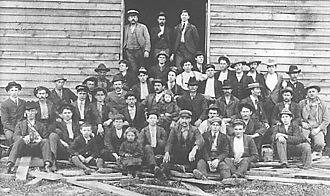Virginia furniture


Virginia furniture refers to the distinctive styles and craftsmanship of furniture produced in the state of Virginia, United States. This furniture is known for its unique blend of English, American, and local influences, reflecting the rich history and cultural heritage of the region.
History[edit]
The history of Virginia furniture dates back to the early colonial period. Early settlers brought with them furniture-making traditions from England, which were then adapted to the resources and conditions of the New World. The furniture from this period often featured simple, functional designs made from locally available woods such as oak, pine, and walnut.
Colonial Period[edit]
During the colonial period, Virginia furniture was heavily influenced by English styles, particularly the Queen Anne style and the Chippendale style. These styles were characterized by elegant lines, cabriole legs, and intricate carvings. Furniture makers in Virginia often incorporated local motifs and materials, creating a distinctive regional style.
Federal Period[edit]
In the late 18th and early 19th centuries, the Federal style became popular. This style was influenced by the neoclassical designs of Thomas Sheraton and George Hepplewhite. Virginia furniture from this period often featured delicate inlays, tapered legs, and symmetrical designs.
19th Century[edit]
The 19th century saw the rise of the Empire style, which was characterized by bold, massive forms and the use of dark woods such as mahogany. This period also saw the influence of the Victorian era, with its ornate and eclectic designs.
Characteristics[edit]
Virginia furniture is known for its high-quality craftsmanship and the use of fine materials. Common features include:
- **Wood Types**: Local woods such as walnut, cherry, and pine were commonly used.
- **Joinery**: Traditional joinery techniques such as dovetail joints and mortise-and-tenon joints were employed.
- **Decoration**: Inlays, carvings, and veneers were often used to decorate the furniture.
Notable Furniture Makers[edit]
Several notable furniture makers have contributed to the legacy of Virginia furniture. These include:
- John Shearer: Known for his distinctive inlaid designs and use of local woods.
- Peter Jefferson: Father of Thomas Jefferson, he was known for his high-quality craftsmanship.
Preservation and Collecting[edit]
Virginia furniture is highly sought after by collectors and historians. Many pieces are preserved in museums and historical homes throughout the state, such as Monticello and Colonial Williamsburg.
Related Pages[edit]
- Colonial America
- Queen Anne style
- Chippendale style
- Federal style
- Empire style
- Victorian era
- Thomas Jefferson
- Monticello
- Colonial Williamsburg
Categories[edit]
Ad. Transform your life with W8MD's Budget GLP-1 injections from $75


W8MD offers a medical weight loss program to lose weight in Philadelphia. Our physician-supervised medical weight loss provides:
- Weight loss injections in NYC (generic and brand names):
- Zepbound / Mounjaro, Wegovy / Ozempic, Saxenda
- Most insurances accepted or discounted self-pay rates. We will obtain insurance prior authorizations if needed.
- Generic GLP1 weight loss injections from $75 for the starting dose.
- Also offer prescription weight loss medications including Phentermine, Qsymia, Diethylpropion, Contrave etc.
NYC weight loss doctor appointmentsNYC weight loss doctor appointments
Start your NYC weight loss journey today at our NYC medical weight loss and Philadelphia medical weight loss clinics.
- Call 718-946-5500 to lose weight in NYC or for medical weight loss in Philadelphia 215-676-2334.
- Tags:NYC medical weight loss, Philadelphia lose weight Zepbound NYC, Budget GLP1 weight loss injections, Wegovy Philadelphia, Wegovy NYC, Philadelphia medical weight loss, Brookly weight loss and Wegovy NYC
|
WikiMD's Wellness Encyclopedia |
| Let Food Be Thy Medicine Medicine Thy Food - Hippocrates |
Medical Disclaimer: WikiMD is not a substitute for professional medical advice. The information on WikiMD is provided as an information resource only, may be incorrect, outdated or misleading, and is not to be used or relied on for any diagnostic or treatment purposes. Please consult your health care provider before making any healthcare decisions or for guidance about a specific medical condition. WikiMD expressly disclaims responsibility, and shall have no liability, for any damages, loss, injury, or liability whatsoever suffered as a result of your reliance on the information contained in this site. By visiting this site you agree to the foregoing terms and conditions, which may from time to time be changed or supplemented by WikiMD. If you do not agree to the foregoing terms and conditions, you should not enter or use this site. See full disclaimer.
Credits:Most images are courtesy of Wikimedia commons, and templates, categories Wikipedia, licensed under CC BY SA or similar.
Translate this page: - East Asian
中文,
日本,
한국어,
South Asian
हिन्दी,
தமிழ்,
తెలుగు,
Urdu,
ಕನ್ನಡ,
Southeast Asian
Indonesian,
Vietnamese,
Thai,
မြန်မာဘာသာ,
বাংলা
European
español,
Deutsch,
français,
Greek,
português do Brasil,
polski,
română,
русский,
Nederlands,
norsk,
svenska,
suomi,
Italian
Middle Eastern & African
عربى,
Turkish,
Persian,
Hebrew,
Afrikaans,
isiZulu,
Kiswahili,
Other
Bulgarian,
Hungarian,
Czech,
Swedish,
മലയാളം,
मराठी,
ਪੰਜਾਬੀ,
ગુજરાતી,
Portuguese,
Ukrainian
